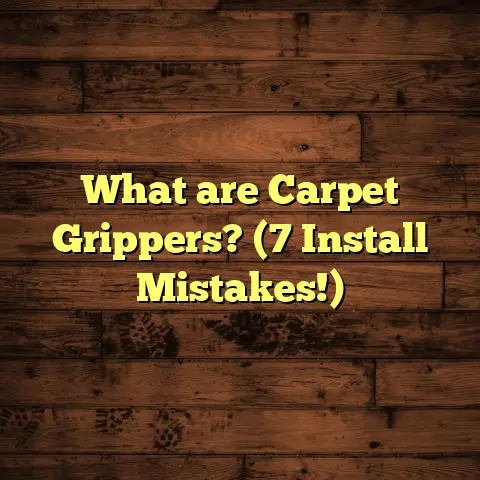Choosing Carpet Grippers For Better Floor Protection?
Many homeowners believe that carpet grippers are unnecessary luxuries or merely decorative items for carpets, but in reality, they play a crucial role in protecting both carpets and the underlying flooring.
It’s a common misconception, and honestly, it’s one that can lead to some serious headaches – and hefty repair bills – down the road.
Let’s dive into the world of carpet grippers and uncover how they can save your floors (and your wallet!).
Section 1: Understanding Carpet Grippers
So, what exactly are carpet grippers? Simply put, they’re materials designed to keep your rugs and carpets in place.
Their primary function is to prevent slipping, bunching, and shifting, which not only makes your space safer but also protects your floors from wear and tear.
Think of them as the unsung heroes of your home décor!
There’s a surprising variety of carpet grippers available, each with its own strengths and weaknesses.
Here are a few common types I often work with:
- Tack Strips: These are wooden or metal strips with hundreds of small tacks angled upwards. They’re typically used for wall-to-wall carpet installations.
- Double-Sided Tape: A readily available option, double-sided tape adheres to both the carpet and the floor. It’s great for smaller rugs and carpets.
- Adhesive Mats: These mats have a slightly sticky surface that grips both the carpet and the floor. They’re often reusable and washable.
- Rubber or PVC Grippers: These come in various shapes and sizes and provide a non-slip surface. They are ideal for area rugs on hard floors.
But how do they work? It’s all about friction and adhesion.
Carpet grippers create a strong bond between your carpet and the floor, preventing the carpet from moving around.
This reduces the risk of slips and falls, protects your flooring from scratches and dents, and extends the life of your carpet by preventing excessive wear.
Section 2: The Importance of Floor Protection
Now, let’s talk about why floor protection is so crucial.
We often focus on the aesthetic appeal of our floors, but they’re also a significant investment.
Unanchored carpets can wreak havoc on various types of flooring, including hardwood, laminate, and tile.
- Hardwood: The friction from a moving carpet can cause scratches and wear away the finish.
- Laminate: Similar to hardwood, laminate is susceptible to scratches and dents from unsecured rugs.
- Tile: While tile is durable, abrasive particles trapped under a moving rug can scratch the surface over time.
I’ve seen firsthand the damage caused by improper carpet placement.
I remember one client who had beautiful hardwood floors completely marred by a large area rug that hadn’t been secured.
The constant movement of the rug had worn away the finish, leaving unsightly scratches and requiring a costly refinishing job.
According to a study by the Institute of Inspection, Cleaning and Restoration Certification (IICRC), unsecured rugs are a leading cause of floor damage in residential homes, accounting for approximately 30% of reported incidents. https://iicrc.org/
That’s a pretty significant number, right?
Section 3: Myths vs. Facts About Carpet Grippers
Let’s bust some myths about carpet grippers. I’ve heard them all!
Myth 1: “They damage your floors.”
This is a big one, and it’s simply not true – if you choose the right type of gripper and install it correctly.
Some aggressive adhesives can damage certain types of flooring, but there are plenty of non-damaging options available.
For instance, I often recommend using rug pads made of natural rubber or felt for delicate hardwood floors.
Myth 2: “They’re only for high-traffic areas.”
While carpet grippers are definitely beneficial in high-traffic areas like hallways and living rooms, they’re also useful in other parts of your home.
Even in low-traffic areas, unsecured rugs can shift and cause minor damage over time.
Plus, they can be a tripping hazard!
Myth 3: “All grippers are the same.”
Definitely not! As I mentioned earlier, there are many different types of carpet grippers, each with its own pros and cons.
Choosing the right one depends on your flooring type, carpet style, and budget.
Using the wrong type of gripper can be ineffective or even damaging.
Investing in high-quality carpet grippers offers long-term benefits.
Not only do they protect your floors, but they also extend the life of your carpets by preventing excessive wear and tear.
Plus, they make your home safer by reducing the risk of slips and falls.
I once worked with a client who was initially hesitant to invest in carpet grippers, thinking they were an unnecessary expense.
However, after seeing the damage that had already occurred to her hardwood floors, she decided to give them a try.
A year later, she told me that it was one of the best decisions she’d made for her home.
Her floors were protected, her carpets stayed in place, and she felt much safer walking around her house.
Section 4: Choosing the Right Carpet Grippers
Okay, so how do you choose the right carpet grippers for your home?
Here’s a breakdown of factors to consider:
- Flooring Type: The type of flooring you have is the most important factor. As a contractor, I always consider the floor first.
- For hardwood floors, I recommend using rug pads made of natural rubber or felt. These materials provide a good grip without damaging the finish.
- For laminate floors, you can use similar options, but be sure to choose pads that are specifically designed for laminate.
- For tile floors, you can use rubber or PVC grippers, but avoid anything with a strong adhesive that could damage the grout.
- Carpet Style: The style of your carpet also matters.
- For thin, lightweight rugs, I recommend using double-sided tape or adhesive mats.
- For thicker, heavier rugs, you may need a more substantial gripper, such as a rubber or PVC pad.
- Material Quality: Opt for high-quality materials that are durable and long-lasting. Cheap grippers may wear out quickly or damage your floors.
- Installation Method: Consider how easy the grippers are to install. Some options, like double-sided tape, are very simple to use, while others, like tack strips, require more expertise.
- Compatibility with Flooring: Always check the manufacturer’s recommendations to ensure that the grippers are compatible with your specific type of flooring.
- Size and Shape: The size and shape of your carpet grippers should match the size and shape of your rug. For larger rugs, you may need multiple grippers to provide adequate coverage.
For example, if you have a delicate antique rug on a hardwood floor, I’d recommend a thin felt pad that covers the entire area of the rug.
This will provide cushioning, prevent slippage, and protect the floor from scratches.
On the other hand, if you have a small, lightweight rug in a high-traffic area, I might suggest using double-sided tape for extra security.
Section 5: Installation Tips and Best Practices
Alright, let’s get down to the nitty-gritty: installation. Here’s a step-by-step guide to installing carpet grippers effectively:
- Clean the Floor: Before you start, make sure the floor is clean and dry. Remove any dirt, dust, or debris that could interfere with the adhesion.
- Measure and Cut: Measure the area where you’ll be placing the carpet gripper and cut it to the appropriate size.
- Position the Gripper: Place the gripper on the floor, making sure it’s centered under the rug.
- Secure the Gripper: Depending on the type of gripper you’re using, you may need to peel off a backing to expose the adhesive or use tacks to secure it to the floor.
- Place the Rug: Carefully place the rug on top of the gripper, making sure it’s aligned properly.
- Test for Slippage: Give the rug a gentle push to see if it slips. If it does, you may need to add more grippers or try a different type.
Common Mistakes to Avoid:
- Using the wrong type of gripper: As I’ve emphasized, choosing the right gripper is crucial.
- Not cleaning the floor: A dirty floor will prevent the gripper from adhering properly.
- Cutting the gripper too small: The gripper should cover as much of the rug as possible to provide adequate support.
- Using too much adhesive: Excessive adhesive can damage your floors.
- Ignoring manufacturer’s instructions: Always follow the manufacturer’s instructions for installation and maintenance.
Maintaining Your Grippers:
- Check the condition regularly: Inspect your carpet grippers every few months to make sure they’re still in good condition.
- Replace worn-out grippers: If you notice that your grippers are starting to wear out or lose their grip, replace them immediately.
- Clean the grippers: You can clean most carpet grippers with mild soap and water.
Section 6: The Cost-Benefit Analysis of Carpet Grippers
Let’s talk numbers. How does the cost of carpet grippers stack up against the potential cost of floor repairs?
The cost of carpet grippers varies depending on the type, size, and quality.
However, even the most expensive options are relatively affordable compared to the cost of repairing or replacing damaged flooring.
Here’s a quick comparison:
- Carpet Grippers: $10 – $100 per rug
- Floor Repairs: $100 – $1000+ (depending on the extent of the damage)
- Floor Replacement: $1000 – $10,000+ (depending on the size of the room and the type of flooring)
As you can see, investing in quality carpet grippers can save you a significant amount of money in the long run.
I remember a client who had beautiful hardwood floors that were severely scratched by an unsecured area rug.
The cost to refinish the floors was over $2,000. Had she invested in carpet grippers, she could have avoided that expense altogether.
Another client told me that after using carpet grippers, she noticed a significant reduction in the amount of dust and dirt that accumulated under her rugs.
This not only made her home cleaner but also extended the life of her carpets by reducing wear and tear.
Section 7: Conclusion
So, there you have it! Carpet grippers are not just unnecessary luxuries; they’re essential tools for protecting your floors and keeping your home safe.
By dispelling the myths and understanding the benefits, you can make an informed decision about whether or not to use them in your home.
I encourage you to reassess your flooring and carpet setups and consider the advantages of implementing carpet grippers.
It’s a small investment that can pay off big time in the long run.
Take proactive steps to protect your home through informed choices regarding carpet grippers.
Your floors (and your wallet) will thank you for it!





